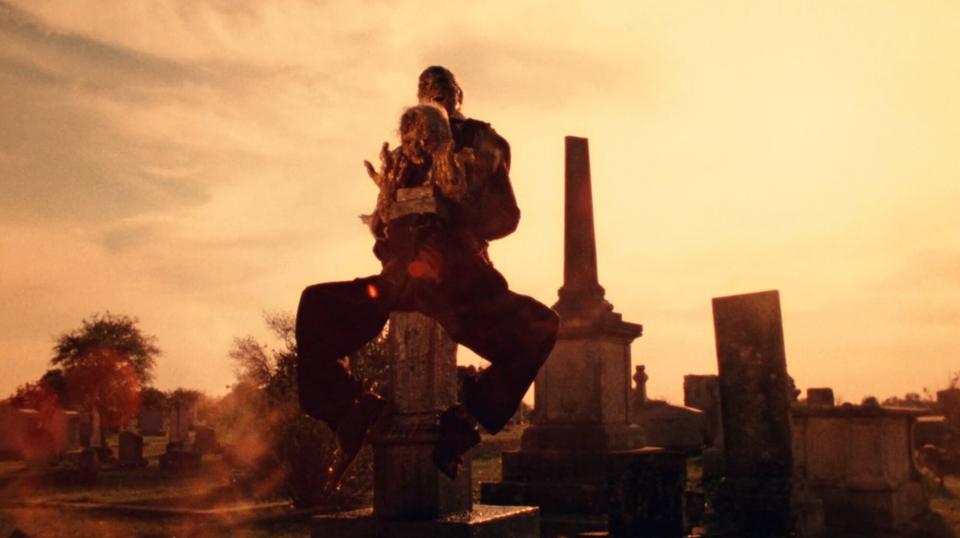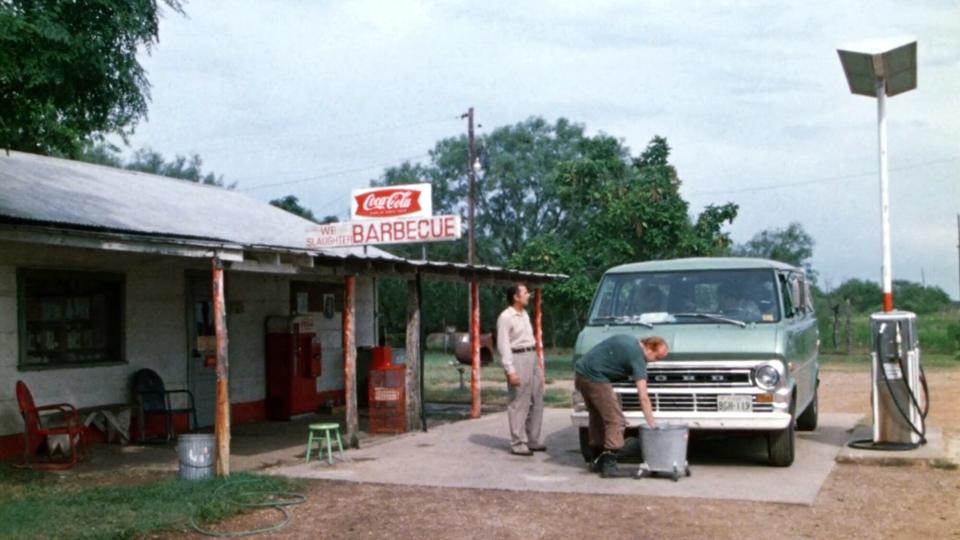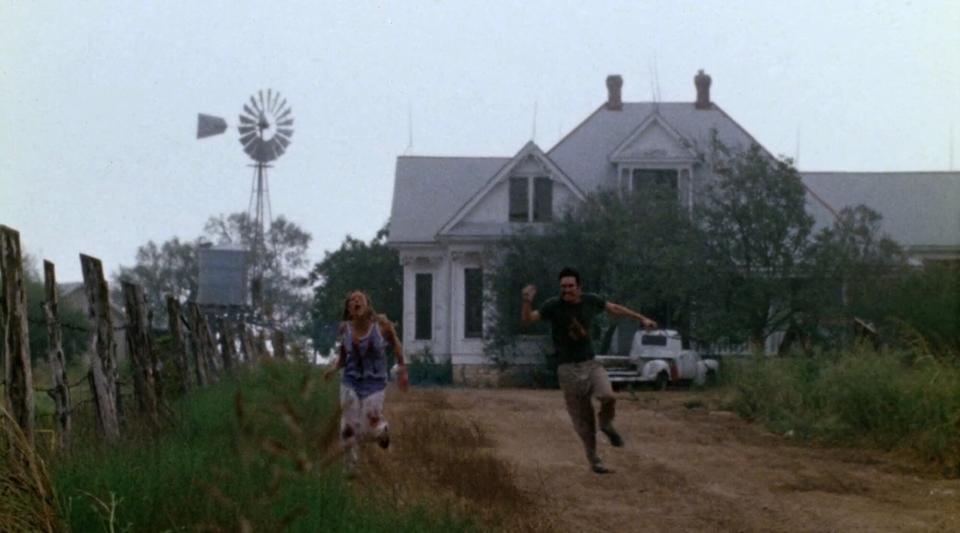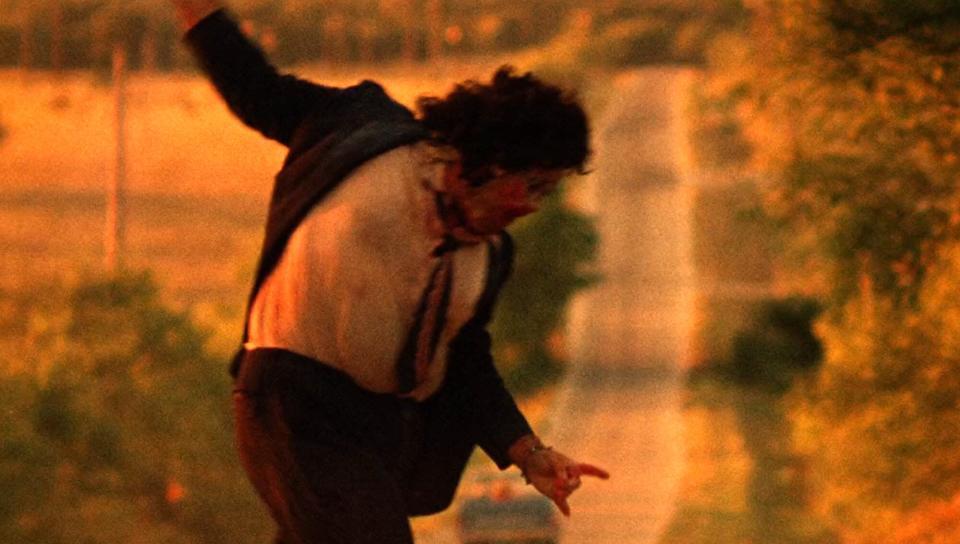Where The Texas Chain Saw Massacre was filmed

- Oops!Something went wrong.Please try again later.
- Oops!Something went wrong.Please try again later.
- Oops!Something went wrong.Please try again later.
Although it revolves around a family of grotesque backwoods cannibals, Texans take a certain pride in The Texas Chain Saw Massacre. There are legends abound about the "real" Leatherface and the "true story" behind Tobe Hooper's 1974 horror classic — none of which are true, but that's never stopped people from telling a good tall tale.
This game-changing independent film was a true low-budget production, shot on location in the East Texas hill country outside of Austin. Several of those locations have since become tourist attractions that draw in genre fans from around the world. Don't worry, the barbecue is safe to eat... now.
The graveyard (Bagdad Cemetery Association in Leander, Tex.)
The Texas Chain Saw Massacre opens on a morbid note, as flashbulbs accompanied by the series' signature sound effect — a perverse whining noise supposedly accomplished by scraping a tuning fork over a piano wire — illuminate the desiccated faces of rotting corpses. Then, the camera pulls back to reveal something even more horrifying: These dead bodies have been dug up and arranged in a sort of grotesque sculpture, tied to the top of a gravestone so it looks like one corpse is holding another's head in its decomposing hands.

Bryanston Distributing Company 'The Texas Chain Saw Massacre' graveyard
Obviously, this "artwork" was made for the movie. Although the caretaker of the Bagdad Cemetery in Leander, Tex., gave Hooper and his crew permission to film on the property (a decision that his wife did not appreciate), even Hooper wasn't bold enough to wire a prop body to a real gravestone — so both the corpses and the headstone were made for the film. The gruesome tableau was meant to evoke the crimes of Ed Gein, a Wisconsin man who dug up the bodies of more than a dozen women between the '40s and mid-'50s, using their limbs to create sick arts and crafts. Gein's crimes shocked the nation when they were revealed in 1957, and he's since inspired a number of horror villains, including Texas Chain Saw's Leatherface (played by the late Gunnar Hansen).
However, the rest of the monuments in the shot were real. If you drive about 30 miles north out of Austin along US-183 Highway North, you'll come up on the small town of Leander. There, you'll find the Bagdad Cemetery Association located at 400 N. Bagdad Rd, where you can park and walk around the cemetery where Sally Hardesty (Marilyn Burns) and her friends go to check on her grandfather's grave. To find the spot where the "dug-up bodies" were staged, go to the large building at the center of the cemetery and follow the path to a fluted pillar with an angled top that sticks up higher than the surrounding stones.
The gas station (We Slaughter Barbecue outside Bastrop, Tex.)
The next stop for Sally, her brother Franklin (Paul A. Partain), friends Jerry (Allen Danziger), Kirk (William Vail), and Pam (Teri McMinn) is a dusty roadside gas station where they stop to regroup after a terrifying encounter with a hitchhiker played by Edwin Neal. To find that particular building, turn around on US-183 and head 70 miles southeast to We Slaughter Barbeque located at 1073 TX-304 on a desolate country road just outside of the tiny town of Bastrop, Tex.

Bryanston Distributing Company The Last Chance Gas Station in 'The Texas Chain Saw Massacre'
In 1974, this building housed a general store that was transformed into the Last Chance Gas Station by Hooper's crew. Famously, a Coca-Cola sign was added to the facade for the movie, with another sign underneath it reading "We Slaughter Barbecue." That sign has since been re-added to the building, part of a painstaking restoration that also includes a rusted-out truck and a memorial bench honoring deceased members of the Texas Chain Saw cast and crew. The words "The Saw Is Family'' have been etched into its base.
The building has been a combination barbecue restaurant/horror museum since 2016, when it was renovated and reopened as the Gas Station. (Confusingly, the business operates both under that name and as We Slaughter Barbecue — don't worry, they're the same place) Now, the joint even has its own YouTube channel and a steady stream of tourists stop to take pictures outside of the building, which looks exactly like it did in the movie. If you go around back, you can also pose with a replica of the green 1972 Ford Club Wagon van featured in the film, or next to a display with giant meat hooks and a metal bucket stained with "blood."
Once you step inside, you're greeted with a cooler full of soft drinks and Shiner Bock beer that's surrounded by Texas Chain Saw memorabilia. Here, you can get a BBQ lunch and browse the restaurant's horror-themed gift shop. If you're brave, you can even stay the night in one of the four cabins out back. General manager Cory Young is a lifelong fan of horror and heavy metal, as well as a local who grew up in neighboring Smithville; as he tells The Texas Bucket List, he often gets requests from tourists who ask him to rev up a chainsaw late at night to frighten their kids. He'd love to, but can't because of insurance regulations, he says, adding, "If you hear a chainsaw, run, because it isn't us."
The farmhouse (Hooper's at the Antler's Inn in Kingsland, Tex.)
The majority of The Texas Chain Saw Massacre takes place in and around a dilapidated rural farmhouse occupied by the Sawyer family, former slaughterhouse workers who turned to cannibalism after the local meat-packing plants closed. The interior of the Sawyers' home reflects their feral lifestyle and twisted take on "family values," and was decorated for the film with roadkill picked up on the side of hot Texas highways and scraps of meat sourced from a local slaughterhouse. It wasn't the most appetizing arrangement — by all accounts, the set smelled awful by the end of filming, with actors even vomiting out the window between takes. So, it's ironic that the same room is now the dining area of a restaurant.

Bryanston Distributing Company The farmhouse in 'The Texas Chain Saw Massacre'
The Victorian-era farmhouse that served as Texas Chain Saw Massacre HQ was located in Round Rock, Tex., at the time of filming. Since then, that area has undergone rapid development, and the house has been moved to Kingsland, Tex., about 60 miles away. (If you're taking a Chain Saw-themed day trip, Kingsland is an hour's drive past Bagdad Cemetery on Texas State Highway 29.) For many years, the place at 1010 King Court in Kingsland was known as the Grand Central Cafe. But in November 2022, it was announced the restaurant was changing its name to Hooper's in honor of the film's director.
Sitting at the bar of Hooper's, the place looks completely different, with only a life-size Leatherface dummy to indicate its importance in horror movie history. Luckily, the other rooms in the house are more recognizable. Just beyond the host stand, you can see the hallway that led to the infamous metal door that Leatherface slams when he captures Kirk and drags him down into the Sawyers' basement to be slaughtered; the wood has been polished and the walls are no longer covered with mangy furs, but the architecture is familiar. The porch and dining room also look the same, albeit with a fresh coat of paint. And when you approach the farmhouse, it looks like Leatherface has gotten into gardening — the landscaping is quite pretty, actually — but it's still definitively, heart-stoppingly the Texas Chain Saw house.
Hooper's is part of a resort called the Antlers Inn, a former railroad inn that's since been converted into a complex with some unique accommodations like this red caboose where you can stay the night if you have a few too many at the Hooper's bar. The Gas Station also offers food and accommodations and is an additional two-hour drive to the southeast along Texas State Highway 71. So you could fit the Bagdad Cemetery, lunch at Hooper's, and dinner at the Gas Station into the same day and be back in Austin by late evening (just be sure to add time for Austin's often-terrible traffic). Or you could stretch the tour into a leisurely two-day trip, with an overnight stop in either Kingsland or Bastrop.
The dirt road (Old Country Road 172 in Round Rock, Tex.)
The Texas Chain Saw Massacre ends with one of the most memorable final sequences in horror history, as Leatherface stands in the middle of a dirt road waving his chainsaw in frustration after "final girl" Sally escapes in the back of a pickup truck driven by a passing motorist. The filming of this scene came dangerously close to disaster: In his autobiography, Chain Saw Confidential, Hansen recalls standing out on that dirt road early in the morning after a long night of filming, wildly swinging a real, functioning chainsaw while half-delirious from lack of sleep. At one point, the chainsaw came within inches of Hooper, who was filming Hansen in close-up. Wild man that he was, Hooper included the shot that almost killed him in the final film.

Bryanston Distributing Company Gunnar Hansen as Leatherface in 'The Texas Chain Saw Massacre'
Of all the locations featured in The Texas Chain Saw Massacre, this dusty lane — known as Country Road 172 in Quick Hill at the time of filming and Old Country Road 172 after development — is the least well-preserved and the most optional. In the 50 years since the film was shot, the area where the Sawyers' country house once stood in Round Rock, Tex., has transformed from the middle of nowhere to a bustling suburb, and the location is barely recognizable today.
There's still a patch of scrub-covered land with a dirt road running down the middle at 1350 W. Louis Henna Blvd in Round Rock, a service road that runs alongside Texas State Highway 45 in an area full of strip malls and office buildings. But it's private property, and the land itself is fenced off. So, the best you can do is stand by the side of the road where the dirt lane meets the highway and imagine what it used to look like. Even this needs to be done with caution, however, given that W. Louis Henna Blvd and Texas State Highway 45 are both busy thoroughfares.
Related content:

